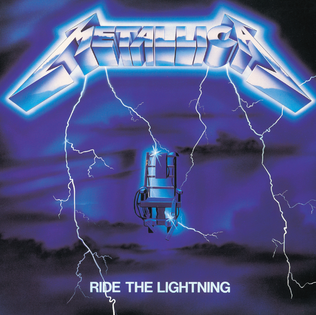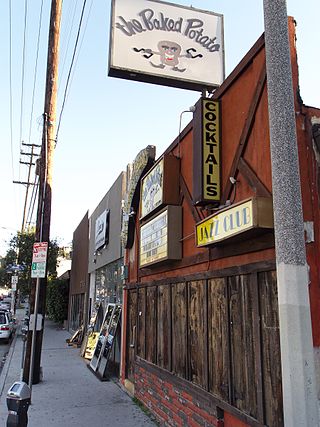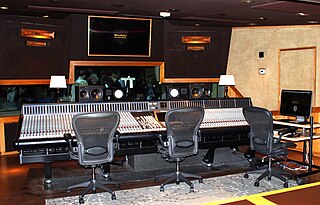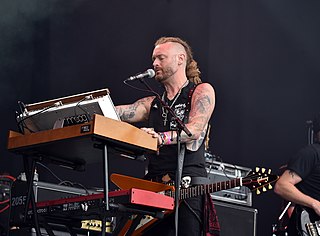
Ride the Lightning is the second studio album by the American heavy metal band Metallica, released on July 27, 1984, by the independent record label Megaforce Records. The album was recorded in three weeks with the producer Flemming Rasmussen at Sweet Silence Studios in Copenhagen, Denmark. The artwork, based on a concept by the band, depicts an electric chair being struck by lightning flowing from the band logo. The title was taken from a passage in Stephen King's novel The Stand, in which a character uses the phrase to refer to execution by electric chair.

Metallica is an American heavy metal band. The band was formed in 1981 in Los Angeles by vocalist and guitarist James Hetfield and drummer Lars Ulrich, and has been based in San Francisco for most of its career. The band's fast tempos, instrumentals and aggressive musicianship made them one of the founding "big four" bands of thrash metal, alongside Megadeth, Anthrax and Slayer. Metallica's current lineup comprises founding members and primary songwriters Hetfield and Ulrich, longtime lead guitarist Kirk Hammett and bassist Robert Trujillo. Guitarist Dave Mustaine, who formed Megadeth after being fired from Metallica, and bassists Ron McGovney, Cliff Burton and Jason Newsted are former members of the band.

Megadeth is an American thrash metal band formed in Los Angeles in 1983 by vocalist/guitarist Dave Mustaine. Known for their technically complex guitar work and musicianship, Megadeth is one of the "big four" of American thrash metal along with Metallica, Anthrax, and Slayer, responsible for the genre's development and popularization. Their music features complex arrangements and fast rhythm sections, dual lead guitars, and lyrical themes of war, politics, religion, death, and personal relationships.

A subwoofer is a loudspeaker designed to reproduce low-pitched audio frequencies, known as bass and sub-bass, that are lower in frequency than those which can be (optimally) generated by a woofer. The typical frequency range that is covered by a subwoofer is about 20–200 Hz for consumer products, below 100 Hz for professional live sound, and below 80 Hz in THX-certified systems. Thus, one or more subwoofers are important for high-quality sound reproduction as they are responsible for the lowest two to three octaves of the ten octaves that are audible. This very low-frequency (VLF) range reproduces the natural fundamental tones of the bass drum, electric bass, double bass, grand piano, contrabassoon, tuba, in addition to thunder, gunshots, explosions, etc.

Killing Is My Business... and Business Is Good! is the debut studio album by American thrash metal band Megadeth, released on June 12, 1985, by Combat Records. At the beginning of 1985, the band was given $8,000 by Combat to record and produce its debut album. The band was forced to fire their original producer and produce the album by themselves, after spending half of the album's budget on drugs, alcohol, and food. Despite the poor production, the album was a well-received effort that obtained strong reviews in various music publications. Killing Is My Business... and Business Is Good! played an essential role in establishing thrash metal as an authentic subgenre of heavy metal music. It explores themes of death, occultism, and violence.

Kill 'Em All is the debut studio album by the American heavy metal band Metallica, released on July 25, 1983, through the independent label Megaforce Records. After forming in 1981, Metallica began by playing shows in local clubs in Los Angeles. They recorded several demos to gain attention from club owners and eventually relocated to San Francisco to secure the services of bassist Cliff Burton. The group's No Life 'til Leather demo tape (1982) was noticed by Megaforce label head Jon Zazula, who signed them and provided a budget of $15,000 for recording. The album was recorded in May with producer Paul Curcio at the Music America Studios in Rochester, New York. It was originally intended to be titled Metal Up Your Ass, with cover art featuring a hand clutching a dagger emerging from a toilet bowl. Zazula convinced the band to change the name because distributors feared that releasing an album with such an offensive title and artwork would diminish its chances of commercial success.
Solid State Logic (SSL) is a British company based in Begbroke, Oxfordshire, England that designs and markets audio mixing consoles, signal processors, and other audio technologies for the post-production, video production, broadcast, sound reinforcement and music recording industries. SSL employs over 160 people worldwide and has regional offices in Los Angeles, Milan, New York City, Paris, and Tokyo, with additional support provided by an international network of distributors. Solid State Logic is part of the Audiotonix Group.

Extasy Records is a Japanese record label founded in April 1986 by Yoshiki Hayashi, co-founder of the heavy metal band X Japan. The label's first release was X's 1986 single "Orgasm".
The Warehouse Studio is a multi-media recording facility and photography studio in Vancouver, British Columbia, Canada, owned by Bryan Adams.

Sound Blaster Live! is a PCI add-on sound card from Creative Technology Limited for PCs. Moving from ISA to PCI allowed the card to dispense with onboard memory, storing digital samples in the computer's main memory and then accessing them in real time over the bus. This allowed for a much wider selection of, and longer playing, samples. It also included higher quality sound output at all levels, quadrophonic output, and a new MIDI synthesizer with 64 sampled voices. The Live! was introduced in August 1998 and variations on the design remained Creative's primary sound card line into the early 2000's.
Record One is a recording studio complex in the Sherman Oaks neighborhood of Los Angeles, California. Originally founded in 1979, the studio has been the site of numerous commercially successful and award-winning recordings. Since 2015, Record One has been under the ownership of Dr. Dre and his business partner Larry Chatman.

"Hangar 18" is a song by American thrash metal band Megadeth from their 1990 studio album Rust in Peace. The song was inspired by a mythical building purportedly located at Wright-Patterson Air Force Base near Dayton, Ohio, where an alien spacecraft or bodies were supposedly stored. The song reached number 25 on the Irish Singles Chart, also reached number 26 on the UK Singles Chart.

The Baked Potato is a prominent jazz club on Cahuenga Boulevard in Studio City, Los Angeles, California, opened by Don Randi in 1970. Randi formed his own group, Don Randi and Quest, as the house band. Over the years it has hosted many live recordings from jazz fusion artists. Larry Carlton recorded Last Nite there in 1986. In 2010 The Baked Potato was named the Best Jazz Club in Los Angeles by Los Angeles magazine. They have cited it as a "mainstay for session players since 1975". Nick Menza of Megadeth collapsed and died while playing here with his band OHM on May 21, 2016.

Westlake Recording Studios is a music recording studio in West Hollywood, California.

Sound City Studios is a recording studio in Los Angeles, California, known as one of the most successful in popular music. The complex opened in 1969 in the Van Nuys neighborhood of Los Angeles. The facility had previously been a production factory of the English musical instrument manufacturer Vox. Throughout the late twentieth century, the studio became known for its signature sound, especially in recording drums and live performances of rock bands.

Paul Moak is an American producer, engineer, mixer, and multi-instrumentalist currently residing in Nashville, Tennessee.

Dubway Studios is an audio post and music production facility located in the Financial District of Manhattan, New York City. Services offered at Dubway Studios include tracking, recording, mixing, mastering, music production, voice-over sessions, and remote connections via Source Connect, phone patch, and Skype.
Larrabee Sound Studios is a recording studio complex in North Hollywood, California, originally established in 1969.
Rumbo Recorders was a recording studio in the Canoga Park neighborhood of Los Angeles, California.


















